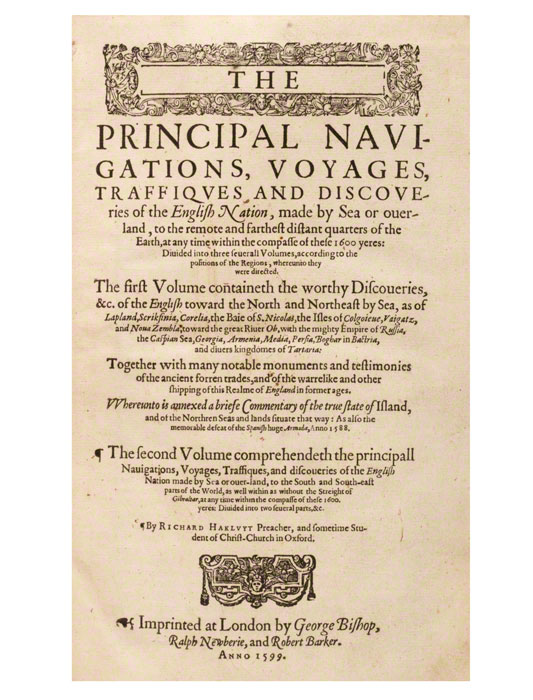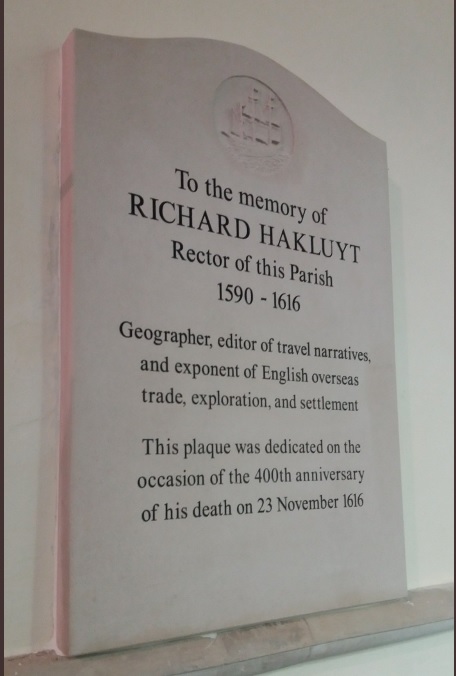An important quadricentennial took place on 23 November 2016: the 400th anniversary of the death of Richard Hakluyt (1552-1616). To mark the occasion, an international group of scholars gathered in Oxford for a conference ‘Richard Hakluyt and the Renaissance Discovery of the World’. In this blog post, Hakluyt@400 organisers, Professors Daniel Carey and Claire Jowitt, once more reflect on the #Hakluyt400 quatercentenary activities in Oxford and Wetheringsett.
– Join the Hakluyt Society on www.hakluyt.com –
England’s pioneering promoter of overseas exploration, commerce and expansion, Richard Hakluyt, assembled the largest selection of English travel accounts of the era, covering every area of activity around the globe. His book The Principal Navigations, Voyages, Traffiques and Discoveries of the English Nation is an astounding compilation of English voyages and discoveries up to his time and marks what we might call the beginnings of the great British historical adventure.
It first appeared in one large c.600,000-word volume in 1589, and then in a much-expanded and updated edition in three volumes between 1598 and 1600. The second edition extended to more than 1.76 million words, containing over 600 individual accounts of travel and exploration by various authors. Hakluyt divided the material into volumes by region, with each then ordered by chronology; its publication was by any reckoning, a truly immense literary and logistical achievement.
Many of the scholars who spoke at the conference are participants in a major international editorial endeavour to prepare the first-ever critical edition of the text, the Hakluyt Edition Project, led by Daniel Carey (NUI Galway) and Claire Jowitt (University of East Anglia), to be published in 14 volumes by Oxford University Press.
The conference was accompanied by two exhibitions: ‘Hakluyt and Geography in Oxford 1550-1650’ at his old college, Christ Church; and ‘The World in a Book: Hakluyt and Renaissance Discovery’ at the Bodleian Library. The programme as a whole, organised by Carey, Jowitt, and Anthony Payne (Hakluyt Society), involved a partnership between the Hakluyt Society, Christ Church, the Bodleian, and the Museum of the History of Science, Oxford.
The Hakluyt@400 events concluded on 27 November 2016 with the unveiling of a wall-plaque in Hakluyt’s honour at his final parish church of Wetheringsett, Suffolk—four hundred years and one day after his burial in Westminster Abbey.
The conference included sessions on themes such as ‘Hakluyt, Oxford, and Centres of Power’ that featured papers by David Harris Sacks, Anthony Payne, and Sebastian Sobecki. A similarly lively session on Hakluyt’s global perspectives in ‘the three corners of the world’ (a reference to Shakespeare’s line from King John) saw Nandini Das discuss ‘Hakluyt and India’, Felicity Stout focus on ‘Hakluyt and Russia’ and Bernhard Klein consider ‘Hakluyt and West Africa’. Taken together, the three papers revealed the transnational, international, and interconnected networks and dimensions of Hakluyt’s work.
Other sessions considered ‘Encounters, communication and technology’, ‘Theatres of war, near and far’, ‘Rival ambitions’, ‘Telling tales’, and ‘Influences and legacy’, and involved speakers representing an appropriately international group—given Hakluyt’s project—ranging from the UK to Ireland, the US, Australia, Canada, Spain, France, and the Netherlands.
The conference featured a keynote from the renowned historian Joyce E. Chaplin (Harvard) who offered an eco-critical reading of Hakluyt’s work, showing how nature was central to The Principal Navigations since God had made the world abundant and open for business (especially to the English). The conference ended with a very well-attended public lecture by historian and broadcaster Michael Wood. ‘Voyages, Traffiques, Discoveries: Stories from the Age of Exploration’, described cross-cultural encounters from Mexico and China and looked at what they tell us about Western ways of seeing the world beyond Europe and other cultures and civilisations—all still, as he put it, ‘burning issues in the 21st century’.
The range, depth, and diversity of the scholarship on display across all sessions was impressive (and gratifying to the organisers), a testament to the continued importance of studying colonial pasts in order to understand, and contribute to, post-colonial futures.
This conference and the commemoration of Hakluyt in 2016 more broadly, provided an opportunity to appreciate fully Hakluyt’s influence and legacy. By offering advice on English colonial and imperial projects to the most powerful figures in the land, including Elizabeth I and James I, and career politicians such as William Cecil, Lord Burleigh, and his son Robert, Hakluyt established himself as one of the chief architects of what was to become a global, oceanic, and mercantile British empire.
Likewise, the series of events enabled us to better understand the ways in which the genre of the travel writing collection, which Hakluyt pioneered in England, was crucial to creating a climate that supported English ambitions for exploration, trade, and expansion. Hakluyt’s editorial labours were thus foundational in developing for the English nation a central role in a global economy.
Readers interested in Hakluyt’s legacy, through the work of the Hakluyt Society (established 1846), can find out further information about activities and publications at: http://www.hakluyt.com/. Further details about the project to publish a scholarly edition of The Principal Navigations can be found at: http://www.hakluyt.org.
NOTE: This report first appeared in the Bulletin of the Society for Renaissance Studies, April 2017. SRS supported the attendance of ten postgraduate and early career scholars at the conference through fee-waiver bursaries. Reproduced with permission of the Society.




